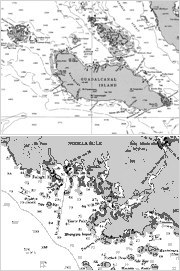|
| |||||||||||||||||
Nicholas arrived in the Guadalcanal area in late September 1942 and was followed in October by O’Bannon and Fletcher. In January 1943, they were joined by Radford, La Vallette, Chevalier, Strong, Taylor, De Haven and Jenkins—some of which had seen duty in the Atlantic—and assigned to Captain R. P. Briscoe’s “Cactus Striking Force” (“Cactus” was the
Nicholas was one the most-photographed destroyers of World War II, as indicated by the number of cards in
Meanwhile, in 1943, a photographer was aboard to capture many aspects of daily life. Here we present 60 of these photos. Click on the green buttons at left to browse among these images; then click on any image to view it in more detail. |
Like all these destroyers, Nicholas performed whatever role was assigned at any moment, typically escort and shore bombardment duty. Unlike Fletcher and O’Bannon,
 she not present for any of the night surface actions at Guadalcanal in late 1942 but she survived several air attacks and was nearby on two occasions when other destroyers were lost to enemy bombers.
she not present for any of the night surface actions at Guadalcanal in late 1942 but she survived several air attacks and was nearby on two occasions when other destroyers were lost to enemy bombers.• On 15 October 1942, less than six hours after parting company with Nicholas, destroyer Meredith and fleet tug Vireo were overwhelmed by planes from aircraft carrier Zuikaku. Survivors drifted for three days and nights, all the while trying to stave off shark attacks. Only 73 destroyermen were rescued—some 236 men from the two ships were lost.
• On the afternoon of 1 February 1943, Nicholas and De Haven were escorting three LCTs home to Tulagi after unloading troops on Guadalcanal to the west of Cape Esperance. With no fighter cover overhead, they were sitting ducks when a flight of enemy dive bombers appeared. De Haven was lost—along with of 167 of her crew of 313—after sustaining three bomb hits.
Nicholas was more fortunate on this occasion. Bombs landing close aboard killed two men (her only crewmembers lost during the war) and damaged her steering gear but she was otherwise spared.
• On 7 May 1743, her “53” gunhouse was destroyed by a hang-fire but that gun mount was soon replaced by one from destroyer Hutchins so that the “Nick” with her by-then-veteran crew could remain in action. “Don’t send her back, she’s a crackerjack!” Admiral Halsey is reported to have said.
Nicholas was the last destroyer damaged in the Guadalcanal campaign.
|



